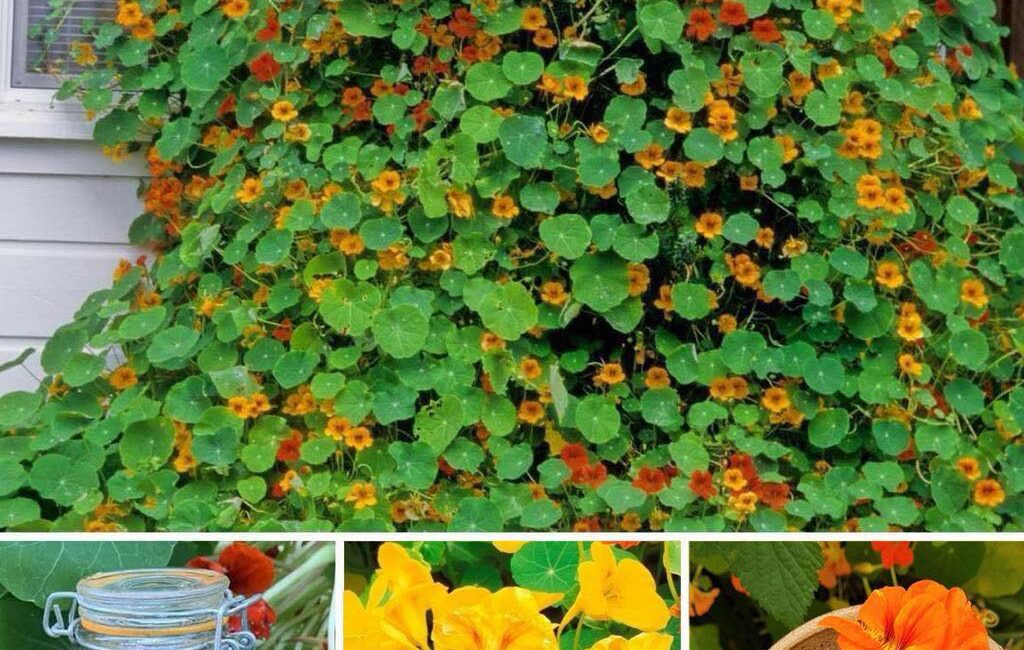Nasturtiums (Tropaeolum majus) are one of the most versatile and easy-to-grow plants you can add to your garden. Their vibrant colors, lush foliage, and rich history make them a favorite among gardeners, culinary enthusiasts, and natural remedy seekers alike. Whether you have a sprawling garden or just a small balcony, nasturtiums are the perfect plant to cultivate, offering a wide array of benefits. From their stunning flowers to their culinary and medicinal uses, there’s no shortage of reasons why everyone should grow nasturtiums in their yard. In this article, we’ll explore the many compelling reasons why you should consider growing nasturtiums, how to care for them, and how they can benefit your garden, health, and environment.
1. Aesthetic Beauty: Vibrant Colors and Unique Flowers
Nasturtiums are known for their bright, showy flowers, which come in a wide range of colors, from vibrant reds, oranges, and yellows to softer pinks and cream shades. The flowers are large, round, and often have a unique, somewhat “tropical” appearance, making them an attractive addition to any garden. Whether grown as a ground cover, in hanging baskets, or as climbing vines, nasturtiums bring a burst of color and joy to your yard, adding visual appeal that lasts throughout the growing season.
The rich, colorful blooms of nasturtiums can contrast beautifully with the greenery of other plants, creating a stunning visual effect. These flowers are perfect for adding a pop of color to vegetable gardens, flower beds, and even as container plants for patios and balconies. Nasturtiums are known for being one of the easiest plants to grow, even for beginner gardeners, so they are perfect for those looking to add a little flair to their garden without requiring much effort or skill.
2. Easy to Grow and Maintain: Perfect for All Skill Levels
Nasturtiums are incredibly easy to grow, making them an ideal choice for gardeners of all experience levels, from beginners to seasoned horticulturists. They thrive in a variety of soil types, from well-drained, loamy soils to more gravelly or sandy soils, making them incredibly adaptable. Nasturtiums also prefer full sunlight, but they can tolerate partial shade, although they may not flower as prolifically in these conditions.
One of the key reasons nasturtiums are so popular is their low-maintenance nature. They require very little attention once planted, and they are relatively resistant to pests and diseases. You don’t need to worry about complex watering schedules or frequent fertilization; in fact, over-fertilizing nasturtiums can result in more foliage and fewer flowers. They also have a natural ability to self-seed, meaning you won’t need to replant them every year. With minimal effort, nasturtiums will continue to thrive year after year, providing you with beauty and color without demanding much of your time.
Additionally, nasturtiums are drought-tolerant, meaning they don’t require constant watering once established. They will generally survive on natural rainfall, making them a great choice for gardeners in areas with limited water resources. Their ability to thrive in poor soil conditions also makes them perfect for regions with less-than-ideal growing environments.
3. Natural Pest Control: Protecting Your Garden from Harmful Insects
Nasturtiums can serve as a natural pest control mechanism in your garden. These vibrant plants attract aphids, whiteflies, and other pests that can damage nearby plants. While this may sound counterintuitive, it’s actually a beneficial trait. By attracting these pests, nasturtiums act as a decoy, keeping the pests away from more vulnerable plants, such as tomatoes, cucumbers, and beans. The pests are drawn to the nasturtium’s leaves and flowers, allowing your other plants to remain pest-free.
Moreover, nasturtiums release compounds in their leaves and flowers that repel certain harmful insects, including beetles and cabbage worms. By strategically planting nasturtiums around your garden, you can help protect your crops from insect damage without the need for harsh chemicals or pesticides. This makes nasturtiums an environmentally friendly and cost-effective solution for natural pest management.
If you are growing vegetables or herbs in your garden, planting nasturtiums alongside them can help promote a healthier, more balanced ecosystem by reducing the likelihood of pest infestations. In this way, nasturtiums contribute to a more sustainable and organic gardening practice.
4. Culinary Uses: A Delicious and Nutrient-Rich Addition to Your Meals
Nasturtiums are not just beautiful to look at – they’re also edible! Both the leaves and flowers of the plant are completely edible and have a peppery, slightly spicy flavor similar to arugula or radishes. This makes them a unique addition to your culinary repertoire. You can use nasturtium flowers and leaves in a variety of dishes, adding a burst of color and flavor to salads, sandwiches, soups, and garnishes.
The flowers are not only visually appealing but also packed with nutrients. Nasturtiums are a good source of vitamin C, iron, and calcium, which are essential for overall health and immune function. They also contain antioxidants, which help fight free radicals in the body and may help reduce the risk of chronic diseases. The leaves, which are also rich in vitamins and minerals, can be used to add a spicy kick to your meals.
Nasturtiums are also commonly used in pickling. The seeds can be harvested and pickled, similar to capers, and used in recipes that call for capers, such as salads, pasta dishes, and sauces. The peppery flavor of the flowers and leaves can complement a variety of dishes, making nasturtiums a versatile and fun ingredient in the kitchen.
5. Medicinal Benefits: Supporting Health and Well-Being
In addition to their culinary uses, nasturtiums have a long history of medicinal use. They are known for their antibacterial, antimicrobial, and anti-inflammatory properties. The plant has been used in traditional herbal medicine to treat a variety of ailments, from respiratory infections to urinary tract infections, as well as minor cuts and wounds.
Nasturtiums are believed to support the immune system, boost circulation, and promote overall wellness. The high vitamin C content in nasturtium leaves and flowers helps strengthen the immune system, while the antimicrobial properties may help fight infections. Additionally, nasturtiums have been used to treat skin conditions, such as eczema and psoriasis, due to their anti-inflammatory properties.
The seeds of the nasturtium plant are also used in herbal remedies to support digestive health. They are thought to promote digestion and improve the function of the liver and kidneys, making them a valuable addition to a detoxification regimen. In recent years, there has been growing interest in using nasturtium as a natural remedy for various ailments, and many people are turning to this plant as a more sustainable and holistic approach to health and wellness.
6. Support for Pollinators: Helping Local Wildlife Thrive
Another reason to grow nasturtiums in your yard is their ability to support local pollinators, such as bees, butterflies, and hummingbirds. The bright, vibrant flowers of the nasturtium plant attract these essential pollinators, providing them with nectar and pollen. Pollinators play a crucial role in the ecosystem by helping plants reproduce and ensuring the continued growth of many of the fruits, vegetables, and flowers that we rely on.
In a world where pollinator populations are declining due to habitat loss and pesticide use, growing plants that support these important insects is more important than ever. Nasturtiums are an excellent choice for encouraging pollinator activity in your yard. By planting a variety of colorful, nectar-rich flowers like nasturtiums, you can help sustain and protect pollinator populations while also benefiting from the beauty they bring to your garden.
How to Attract Pollinators with Nasturtiums
To maximize the impact of nasturtiums on pollinators, plant them in areas of your garden that receive plenty of sunlight. These plants are especially attractive to bees and butterflies, who are drawn to the bright, bold colors of the flowers. If you are growing vegetables or fruits that require pollination, consider planting nasturtiums nearby to help attract more pollinators and improve your crop yields.
7. Environmental Benefits: Improving Soil and Reducing Waste
Nasturtiums are not only good for your garden and health, but they can also benefit the environment. These plants help improve soil health by fixing nitrogen in the soil, a key nutrient for plant growth. They are also known to suppress the growth of weeds, reducing the need for chemical herbicides in your garden. By providing a natural way to enhance soil quality and minimize the need for chemical inputs, nasturtiums contribute to more sustainable gardening practices.
Furthermore, nasturtiums can be composted, which helps reduce garden waste. When the plants start to die off at the end of the season, they can be added to your compost pile, where they will break down and contribute valuable nutrients back to the soil. This sustainable practice helps reduce landfill waste and enriches the soil for future planting seasons.
Conclusion: Nasturtiums as a Must-Have Garden Addition
In summary, there are countless reasons why everyone should grow nasturtiums in their yard. From their stunning aesthetic appeal to their culinary and medicinal uses, nasturtiums are an incredibly versatile plant that benefits your garden, your health, and the environment. They are easy to grow, low-maintenance, and highly beneficial to pollinators, making them an ideal choice for gardeners of all experience levels.
By planting nasturtiums in your yard, you are not only adding beauty and color but also creating a more sustainable and eco-friendly garden. Whether you’re looking to enjoy their vibrant flowers, use them in your cooking, or harness their medicinal properties, nasturtiums offer a wealth of benefits that will enhance your gardening experience. So, what are you waiting for? Make sure nasturtiums are part of your garden this year and reap the many rewards they have to offer!




